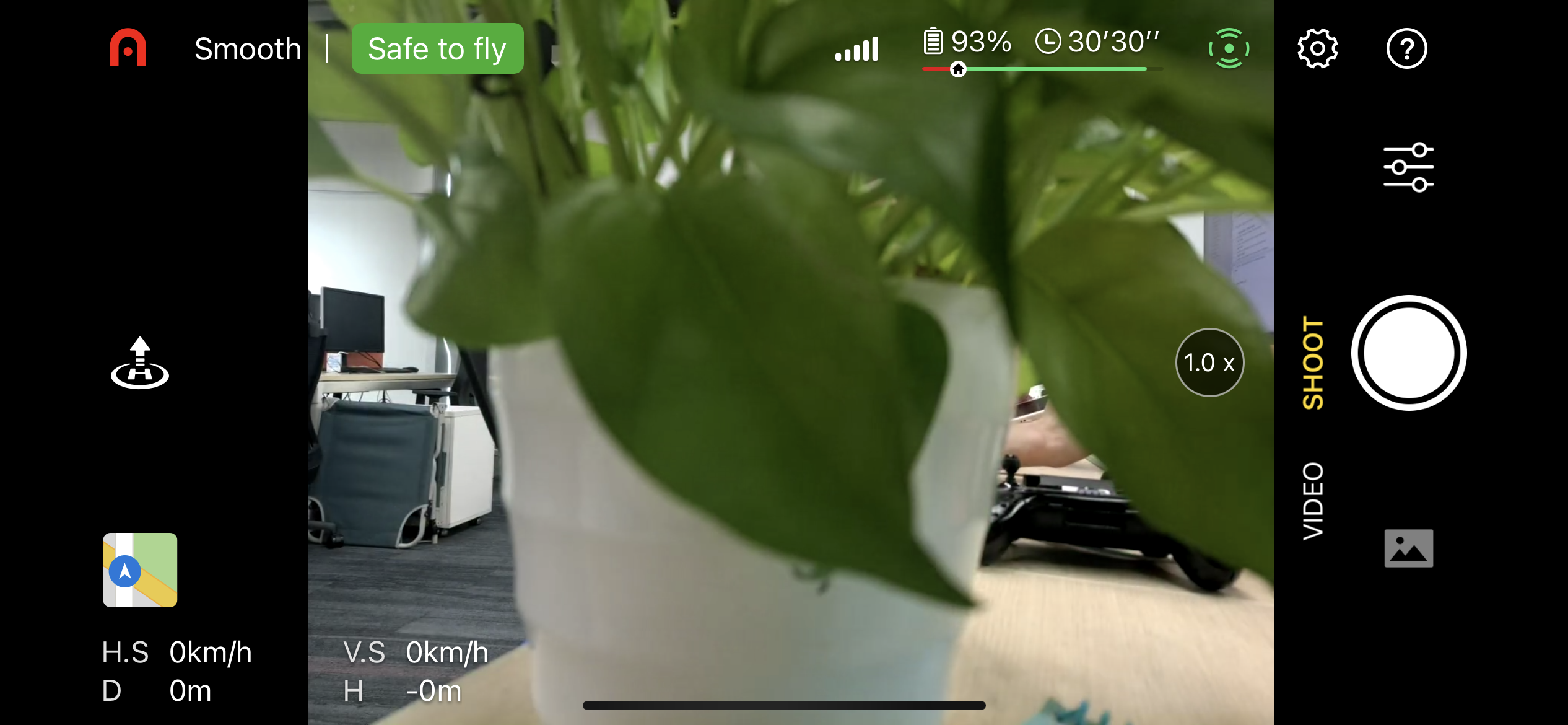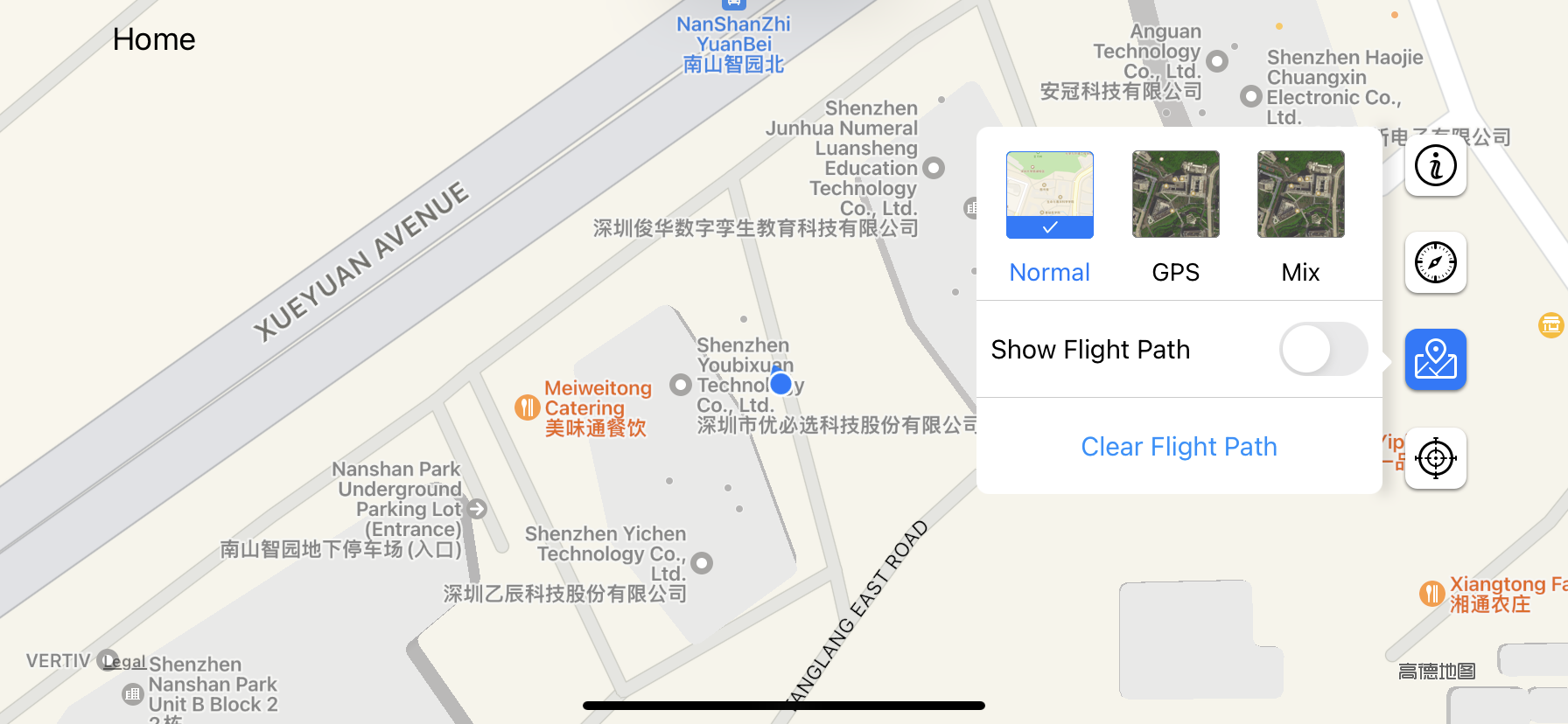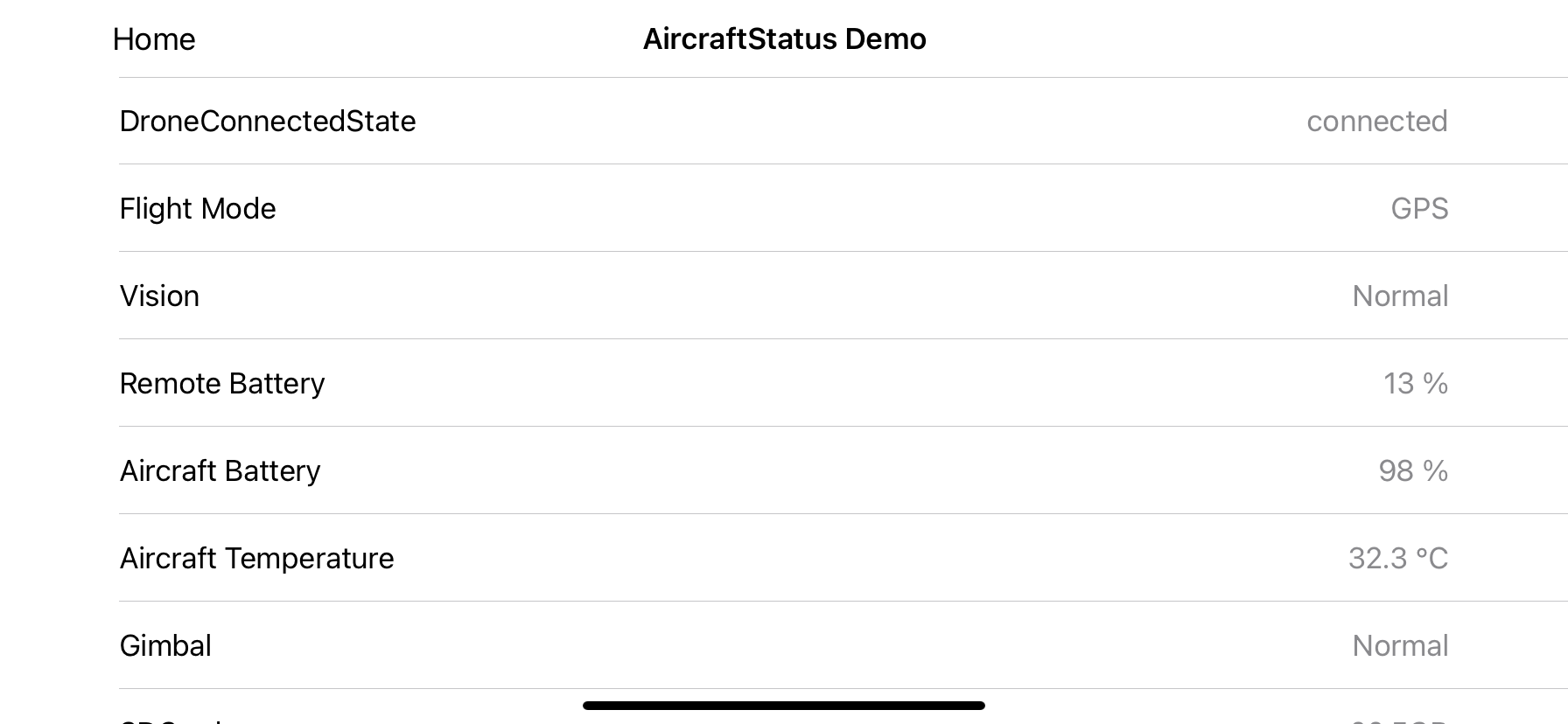AUTEL iOS UX SDK User Manual
1. Introduction
To speed up application development, AUTEL UX SDK provides the following commonly used core functionalities:
- Showing the image transmitted by the camera in real time
- Showing the real-time position and flight paths of the aircraft on the map
- Providing camera shooting, video recording, parameter setting, and albums
- Showing the flight status information, including the aircraft altitude, speed, battery level, and signal strength
- Allowing developers to view and change aircraft settings
- Having basic functionalities such as automatic takeoff, landing, and return to home.
Having basic functionalities such as automatic takeoff, landing, and return to home.UTEL UX SDK provides UI elements that have the above functionalities. By using the default AUTEL UX SDK components, developers can quickly create an application that looks like the below without adding additional lines of code:
2. Concepts Overview
The UI elements provided by the AUTEL UX SDK are categorized into the following types:
- Component: An independent UI element that shows status information or offers simple control (for example, a battery level indicator or an automatic takeoff button).
- Component set: An organized collection of components that are related to each other (for example, the flight status bar).
- Panel: A complex menu and settings view with rich UI elements (for example, the camera settings panel).
- Page: A complete UI functional module (such as the image transmission page or map page).
All UI elements can simply be implemented in an application without extra maintenance. They are already bound to the AUTEL Mobile SDK, and will start updating themselves after being instantiated.
3. AUTEL Mobile SDK User Manual
AUTEL UX SDK is built on top of AUTEL Mobile SDK. Before using AUTEL UX SDK, familiarize yourself with how to access and use AUTEL Mobile SDK. For specific usage guidelines, see Mobile SDK Overview and AUTEL iOS Mobile SDK Development Workflow
4. AUTEL UX SDK Dependency
Mobile SDKprovides APIs to access various functional modules of the drone.AutelUXFrameworkis the basic function library encapsulated by Autel, providing some tool classes, basic controls, basic components such as map components, etc.

4.1 Import Mobile SDK
Import the AUTEL Mobile SDK, including the following three frameworks: AUTELSDK.xcframework, AUTELWidget.xcframework, and DDSimpleNetLogger.xcframework.
ow to import the AUTEL UX SDK:TARGETS -> Build Phases -> Click + on the upper left corner -> New Copy Files Phase, and then under Embed Frameworks, set Destination to Frameworks.
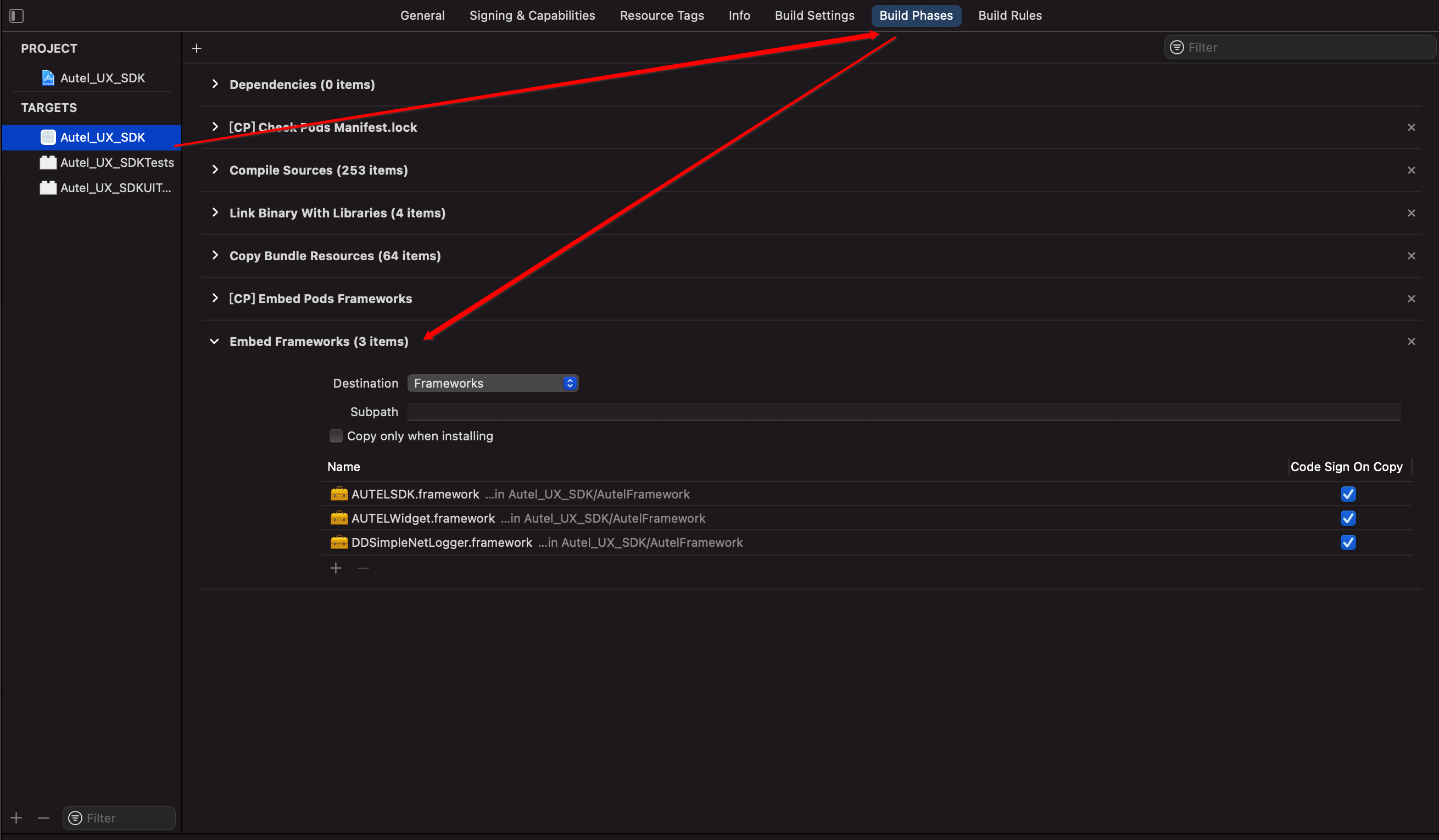
4.2 Import AutelFramework
Import AutelFramework by referring to the instructions on how to import the AUTEL UX SDK: TARGETS -> General -> Under Frameworks, Libraries, and Embedded content, import AutelUXFramework.framework.
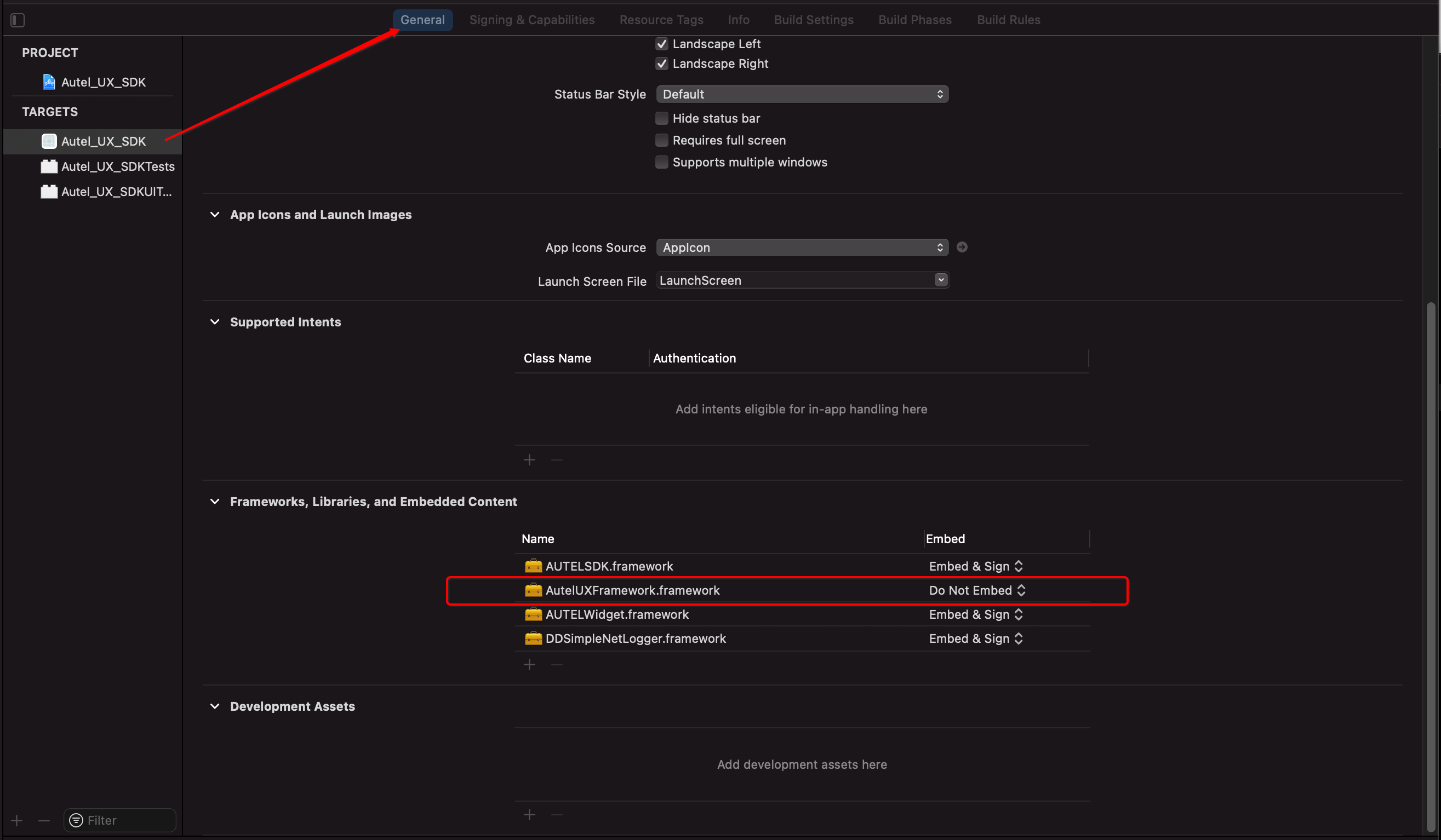
Note: For AutelUXFramework.framework, select Do Not Embed
5. Functional Modules of AUTEL UX SDK
The AUTEL UX SDK includes the following functional modules:
- Real-time transmitted image display page
- Map display page
- Component collection of flight parameter status bar
- Camera control panel
- Camera parameter settings panel
- Attitude indicator display component
- One-touch takeoff/one-touch landing component
- Flight parameter settings page
- Gimbal angle adjustment component
- Zoom adjustment component
- Album preview page
5.1 Real-time Transmitted Image Display Page
5.1.1 Functionality
This module allows you to obtain and play real-time video images captured with an aircraft camera.
5.1.2 Key Classes
VideoOpenGLView
Video rendering view class
VideoStreamPlayManager
Real-time video stream player management class (single instance)
5.1.3 Usage
Add the video rendering page and create the page layout.
lazy var videoPlayView : VideoOpenGLView = {
let view = VideoOpenGLView.init()
return view
}()
view.addSubview(videoPlayView)
videoPlayView.snp.makeConstraints { (make) in
make.edges.equalToSuperview()
}
Start video rendering.
VideoStreamPlayManager.sharedInstance().setPlayView(to: videoPlayView)
Stop video rendering.
VideoStreamPlayManager.sharedInstance().stopPlayAndRemoveView()
Implement the callback in the API that monitors the changes of the real-time video stream resolution and aspect ratio.
VideoStreamPlayManager.sharedInstance().ratioHandle = { [weak self] ratio in
GCDUtils.main {
self?.updatePlayerView(ratio)
}
}
Obtain the real-time video stream resolution parameter.
let size = VideoStreamPlayManager.sharedInstance().renderAspectRatio
Enable the overexposure prompt feature.
VideoStreamPlayManager.sharedInstance().showOverExpose = true /// Enable or disable the overexposure prompt feature. It is disabled by default.
Obtain the video image rendering type parameter.
When the ratio of the image width to the image height is 16:9, set renderType to scaleAspectFill. Otherwise, set renderType to scaleAspectFit.
let renderType = VideoStreamPlayManager.sharedInstance().renderType
For more usage of VideoStreamPlayManager and VideoOpenGLView, see ATConsoleViewController and BaseVideoViewController classes.
5.2 Map Display Page
5.2.1 Functionality
The map page offers street maps, GPS coordinates, and hybrid maps. It allows you to lock directions, locate your current position, and let the aircraft go home. You can also choose whether to show No Fly Zones and view the real-time position and flight paths of the aircraft on the map.
5.2.2 Key Classes
ATBaseMapViewController
Map view controller class
ATMapManager
Map management class
ATMapDrawManager
Map drawing management class
ATNoFlyZoneManager
ATNoFlyZoneViewModel
Data management class and data model class of No Fly Zones
AutelLocationDelegate
/** Implement the callback when the location permission is changed */
func locationManager(didChangeAuthorization status: CLAuthorizationStatus)
/** Implement the callback when the location is updated */
func locationManager(didUpdateLocations locations: [CLLocation])
/** Implement the callback when the heading is changed */
func locationManager(didUpdateHeading newHeading: CLHeading)
/** Implement the callback when the location error message is received */
func locationManager(didFinishDeferredUpdatesWithError error: Error?)
/** Check whether the location is successfully obtained */
func locationManager(didFailWithError error: Error)
Map positioning proxy callback interface, including: positioning permission change callback, positioning update callback, map orientation change callback, positioning error information callback, and detecting whether the positioning callback is obtained.
5.2.3Frequently Used Map Components and Functional APIs
This section describes the frequently used map components and functional APIs, including the following:
Component for switching map types
ATMapSettingView.mapTypesView
Component for showing or hiding aircraft trails and flight paths
ATMapSettingView.mapTypesView
API: ATMapManager.manager.setting.isShowFlightRoute
API for updating the aircraft position and home point in real time
ATMapDrawManager
func updateHomeLocation(_ coordnidate: CLLocationCoordinate2D)
func updateDroneLocation(_ coordinate: CLLocationCoordinate2D)
API for locating your position and the aircraft position
func mapLocateAround(_ type:ATMapLocateAroundType)
Component for displaying No Fly Zones and Restricted Altitude Zones
ATMapDrawManager.limitUpdateNoFlyZone
Component for displaying No Fly Zones and Restricted Altitude Zones
mapManager.headingUpdateObservable
5.2.4 ATMapManager
ATMapManager is the map management class that manages all functionalities of the current map object. All the object functionalities can be shown on the ATBaseMapViewController.
ATMapManager enables you to configure the location permission, update the position, and change the aircraft heading.
ATMapManager manages the map locations on your phone and displays the aircraft positions.
ATMapManager has a built-in function for requesting and displaying No Fly Zones.
ATMapDrawManager.limitUpdateNoFlyZone
5.3 Component Collection of Flight Parameter Status Bar
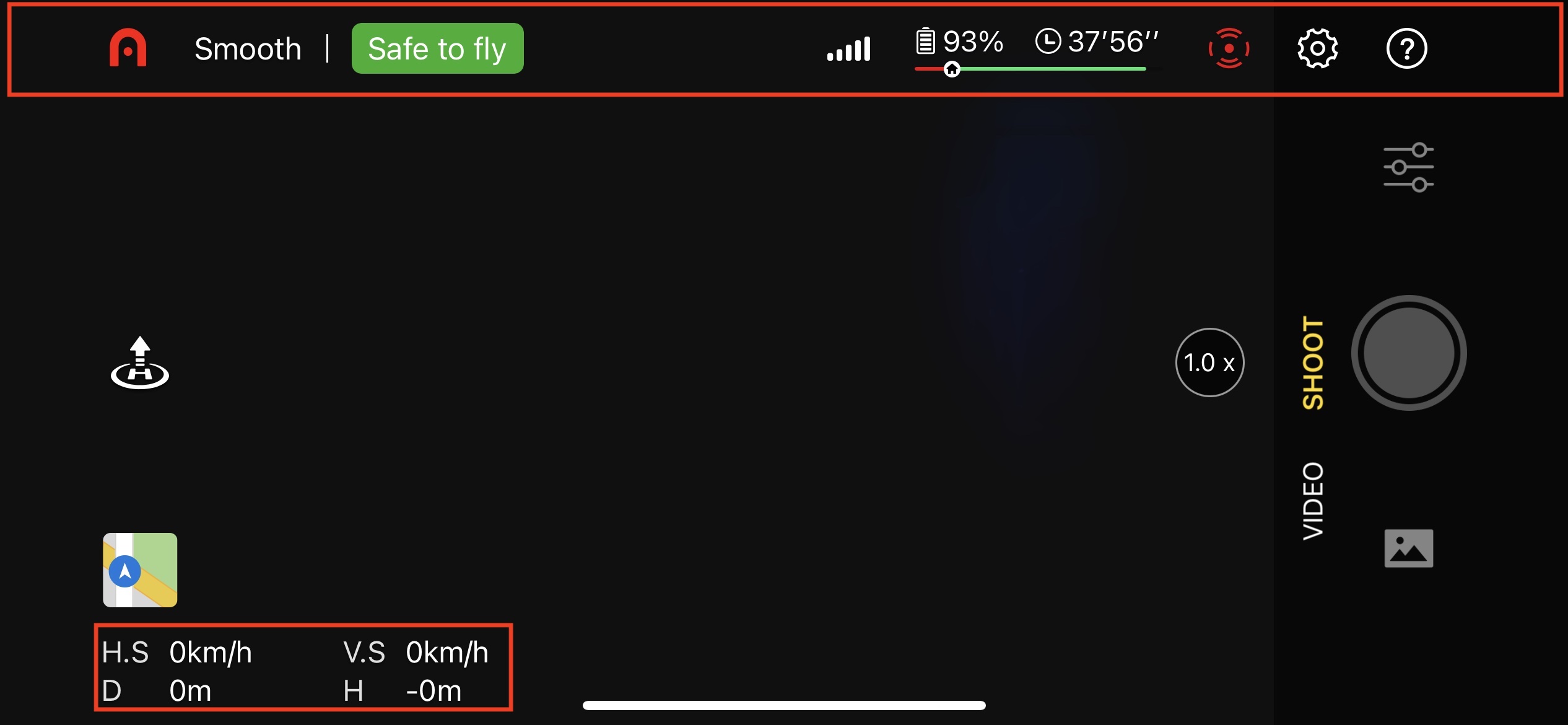
5.3.1 Functionality
The flight parameter status bar displays the obtained and updated flight status information, including the flight status, flight speed, altitude, and the current battery level.
5.3.2 Key Classes
ATFlyNavigationView
Description:
Displays the mode status, device status, and hardware information including the GPS signal strength, image transmission signal strength, battery percentage, remaining flight time, and visual obstacle avoidance component.
ATFlyInfoView
Description:
Displays the horizontal and vertical flight speed, flight distance, and flight altitude.
5.4 Camera Control Panel and Parameter Settings Panel

The two modules enable you to use camera shooting, video recording, and parameter setting functions.
5.4.1 Camera Control Panel
5.4.1.1 Functionality
- Support switching between the photo-taking and video-recording modes
- Support taking photos
- Support video recording
- Provide an entry for previewing the album
ATConsoleRightControlView
Camera mode switching panel. The demo provides two modes (photo-taking and video-recording) for you to switch.
5.4.2 Camera Parameter Settings Panel
5.4.2.1 Functionality
Support setting photo-taking parameters: photo-taking mode, photo format, photo resolution, and white balance
Support setting video-recording parameters: video resolution, frame rate, video format, and video encoding
ATCamaraSettingViewController
CameraMenuBranch lists the specific camera parameter menus that you can configure. If you want to use other cameras, refer to this enumeration.
enum CameraMenuBranch {
case photoFormat = "PhotoFormat"
case videoFormat = "VideoFormat"
.......
}
The panels for configuring photo-taking and video recording in the demo are ATPhotoModeSettingView and ATVideoModeSettingView classes.
The directories where the two classes are located are shown below.

5.4.2.2 Key Classes
The key classes used for configuring camera parameters are listed below:
ATPhotoModeSettingView
Panel for configuring the photo-taking mode
ATVideoModeSettingView
Panel for configuring the video recording mode
CameraParametersSetter
API class for setting camera parameters
CameraParametersGetter
API class for obtaining camera parameters
CameraMenuItem
Camera menu class
CameraMenuItemPicker
Class for obtaining camera menu and submenu items
CameraSelection
Camera parameter caching class
5.4.2.3 Class Relationships
ATPhotoModeSettingView、ATVideoModeSettingView enable you to use camera APIs to obtain and set camera parameters.
CameraParametersSetter、CameraParametersGetter are classes formed by encapsulating the APIs used for setting and obtaining camera parameters. They can save camera parameters through CameraSelection while obtaining and setting them.
CameraMenuItem is an abstraction of camera parameter settings. It associates camera menu items with submenu items through a chain.
CameraMenuItemPicker is a class for assisting the management of camera menus. You can use this class to obtain the submenus of camera menus.
5.5 Attitude Indicator Display Component

5.5.1 Functionality
The attitude indicator shows the aircraft position, home position, my position, speed, altitude, and distance.
5.5.2 Key Classes
AircraftAttitudeBallView
Description:
The attitude indicator shows the relative direction and position of the aircraft, home point, and remote controller. The central point is the home point, N points true north, and the heading of your phone serves as a reference.
The gray part in the middle of the attitude indicator shows how your aircraft is tilted currently, and the tilt angle is the current tilt angle of the aircraft. If the horizontal line of the gray part is level, the aircraft is not tilted. The attitude indicator represents a distance of 0 - 500m. If the aircraft is 500m away, it will stay on the boundary of the indicator.
5.6 One-touch Takeoff/One-touch Landing Component

5.6.1 Functionality
The one-touch takeoff/one-touch landing component enables you to take off or land an aircraft.
5.6.2 Key Classes
ATTakeOffLandingView
Description:
Class for controlling the takeoff and landing of an aircraft.
5.7 Aircraft Flight Status Page
5.7.1 Functionality
The flight status page enables you to monitor the aircraft connection status, flight mode, visual status, remote controller status, battery status, battery temperature, gimbal status, SD card status, and flash memory status in real time. It also processes and displays the monitored data.
5.7.2 Key Classes
AircraftStatusViewController
Flight status view controller class, which monitors the flight status data reported by the SDK, including the data related to the remote controller, visual component, camera, gimbal, and battery, and displays the current aircraft status in real time.
AircraftStatusParameters
Flight status parameter model class, which converts the flight status reported by the SDK into data models that can be displayed on a page.
5.8 Gimbal Angel Adjustment Component

5.8.1 Functionality
Long press the image transmission page to display the gimbal angle adjustment component. By dragging the component up and down, you can pitch the gimbal upwards and downwards and adjust the pitch angle.
5.8.2 Key Classes
ATConsoleGimbalSpeedView
Gimbal angle adjustment component. You can only adjust the pitch angle, not the roll angle.
5.9 Zoom Adjustment Component

5.9.1 Functionality
Long press this button to display the thumb view. Reset the zoom level by pressing this button lightly.
5.9.2 Key Classes
ATCameraZoomView
Description:
Zoom adjustment class, which enables you to adjust the current zoom to x-times zoom (1 to 8-times zoom).
5.10 Album Preview Page
5.10.1 Functionality
You can view and download photos and videos on the album preview page. The page offers the following functions: preview, play, download, and delete album files or view local videos and photos in your phone album.
Local album: system album of your mobile phone
ATAlbumViewController
5.10.2 Key Classes
ATMediaDataManager
Image and video management class (single instance)
ATMediaDownloader
File downloading management class
5.10.3 API Usage
Set the storage type
Set ATAlbumStoreType to sdCard. Then the operations, such as retrieving the album list, downloading, and deleting will be performed on files stored in the SD card. Similarly, if you set ATAlbumStoreType to lash or local, the operations will be performed on files stored in the flash memory or system album of your phone.
func switchDidChange(index: Int) {
guard let type = ATAlbumStoreType(rawValue: index) else {
return
}
ATMediaDataManager.shared.storeType = type
collectionView.mj_header?.beginRefreshing()
}
Obtain the default storage type
func setupSwitchView() {
let defautIndex = ATMediaDataManager.shared.defaultType.rawValue
switchView.setTitleArray(titleArray: ["ATAlbumSDCard".fLocal("ATAlbum"),
"ATAlbumAirborneFlashMemory".fLocal("ATAlbum"),
"ATAlbumLocal".fLocal("ATAlbum")], selectIndex: defautIndex)
switchView.delegate?.switchDidChange(index: defautIndex)
}
Obtain the thumbnail picture of your first album file
ATMediaDataManager.shared.getFirstThumbImage(completion: {[weak self] (image) in
if image != nil {
/// The thumbnail picture is obtained successfully
}
})
Obtain the album file list
File type: All, photo, video
Page: the page on which the album files you want to obtain are located
Number of files on a single page: the maximum number is 50
ATMediaDataManager.shared.getFileList(with: .all, offset: pageIndex == 0 ? 0 : allMediaItems.count, count: pageCount) {[weak self] (result) in
switch result{
case let .success(medias):
self.configMediaItems(medias)
case let .failure(error):
self.configMediaItems([])
}
}
Download a single album file
resoType: sharpness. Values include low, high, and original
ATMediaDataManager.shared.startDownload(media: media, resoType: .original) { result in }
Download a group of album files
ATMediaDataManager.shared.downloadOriginal(medias: medias) /// medias Returned by get album list request
Download the video and then cache it before you play it.
ATMediaDataManager.shared.fetchPlayerItem(media: media) {(result) in
GCDUtils.main {
switch result{
case let .success(item):
playerView.setPlayerItem(item)
playerView.player?.uniqueID = media.uniqueID
playerView.player?.play()
case let .failure(error):
ToastManager.shared.show(title: error.localizedDescription)
}
}
}
Cancel downloading
ATMediaDataManager.shared.cancelDownload()
Cancel all downloading tasks
Remove all tasks from the download queue and cancel the download
ATMediaDataManager.shared.cancelAllDownload()
Delete a group of album files
ATMediaDataManager.shared.delete(medias: medias, progress: progressHandler) { result in
GCDUtils.main {
completionHandler?()
switch result{
case let .success(medias):
self.removeItems(medias: medias)
self.showSuccessAlert()
case .failure(_):
self.showFailedAlert()
}
}
}
Cancel deletion
ATMediaDataManager.shared.cancelDelete()
Obtain the path of the local album thumbnail picture
let path = ATMediaDataManager.shared.fetchThumbImagePath(media: media)
Obtain the path of the original file in the local album
let path = ATMediaDataManager.shared.fetchOriginalImagePath(media: media)
Use the callback API for obtaining the download progress, speed, and task completion information
let downloader = ATMediaDataManager.shared.downloader
downloader.progressHandler = {[weak progressView, weak pop] count,progress in
GCDUtils.main {
progressView?.update(progress)
countTitle = String(format: "ATAlbumDownloading".fLocal("ATAlbum"), count + 1,mediasCount)
pop?.viewModel.title = countTitle + speedTitle
pop?.update()
}
}
downloader.speedHandler = {[weak pop] speed in
GCDUtils.main {
speedTitle = ": " + speed + "\n\n" + "ATAlbumDownloadSpeedLow".fLocal("ATAlbum")
pop?.viewModel.title = countTitle + speedTitle
pop?.update()
}
}
downloader.completionHandler = { [weak self,weak pop] error in
GCDUtils.main {
pop?.hide(animiated: true)
if error != nil{
self?.showSuccessAlert(false)
}else{
self?.showFailedAlert(false)
}
}
}
5.11 Aircraft Parameter Settings Page
5.11.1 Functionality
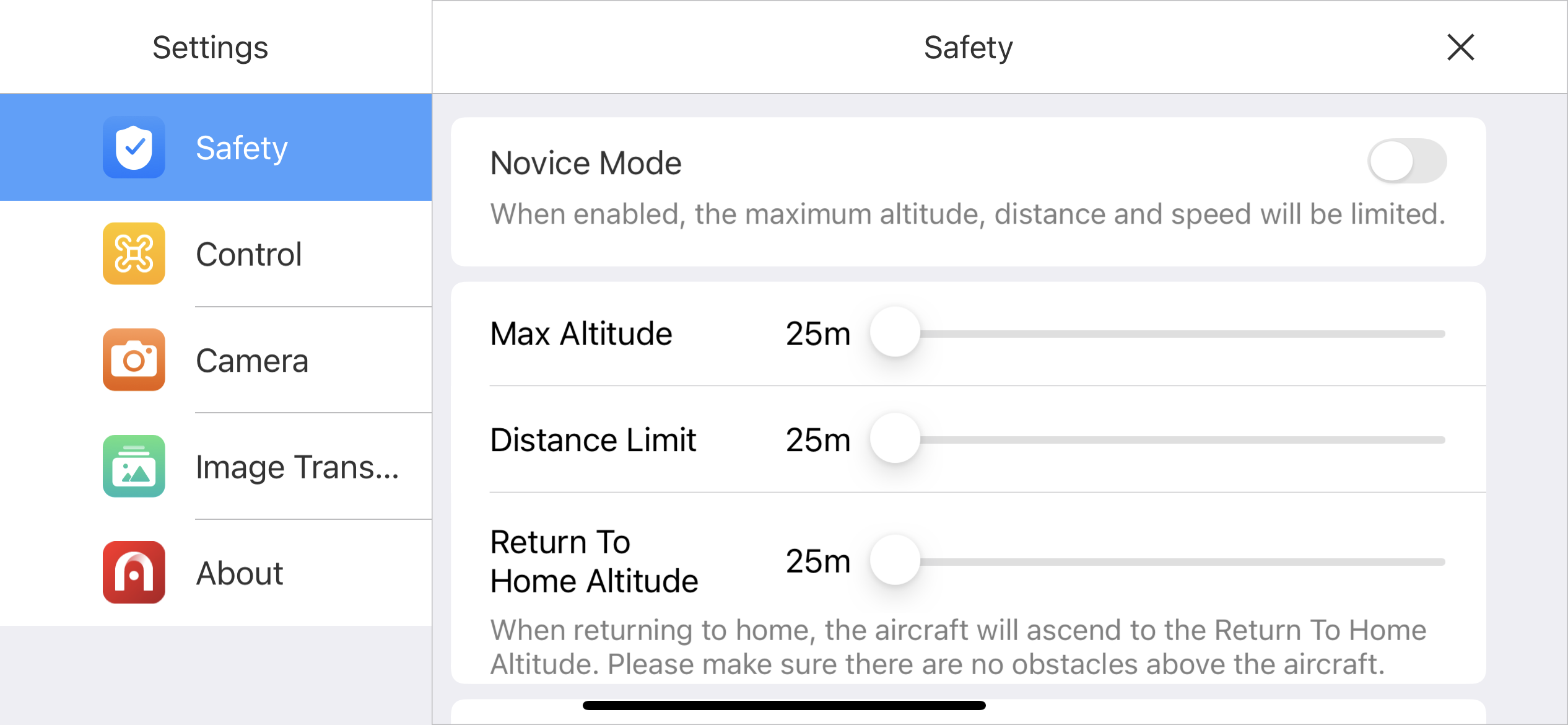
This module displays commonly used parameter settings of the aircraft, including:
- Support setting flight control parameters
- Support adjusting the altitude limit of the aircraft
- Support adjusting the distance limit of the aircraft
- Support adjusting the altitude for returning to home
- Support enabling or disabling obstacle avoidance
- Support setting battery parameters
- Support setting parameters about the gimbal and remote controller
upport gimbal and remote control parameter setting
- Support switching the gimbal mode
- Support configuring the heading of the gimbal
- Support enabling and disabling the upward gimbal rotation feature
- Support switching the remote sensing mode of the remote controller
Support setting common camera parameters
- Support enabling or disabling the histogram feature
- Support enabling or disabling the overexposure prompt feature
- Support enabling or disabling the defogging feature
- Support obtaining or formatting the storage information
Support setting image transmission parameters
- Support configuring the sharpness for image transmission
- Support configuring the frequency bands for image transmission
Support displaying aircraft version information
- Support displaying the serial number of each module
- Support displaying the firmware version of each module
The directories where the key classes are located in the demo project are shown below:

5.11.2 Key Classes
ATSettingsMainViewController
Class of the aircraft parameter settings main page
ATSettingsSafeViewController
Class of the flight controller settings page
ATSettingsControlViewController
Class of the gimbal/remote controller parameter settings page
ATSettingsDSPViewController
Class of the image transmission parameter settings page
ATSettingsShootingViewController
Class of the common camera parameter settings page
ATSettingsAboutViewController
Class of the firmware version display page
